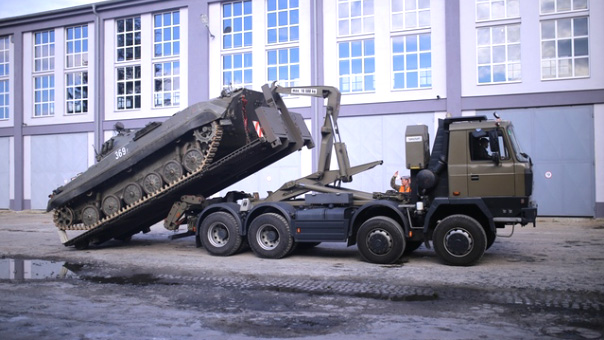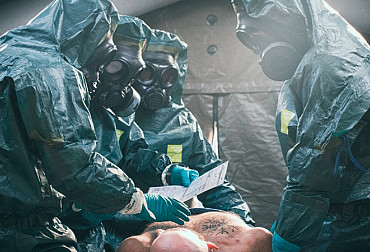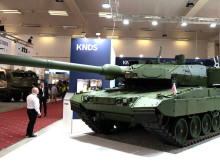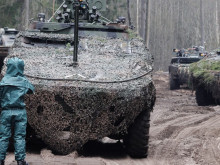Tatra trucks as the basis for the logistics of the Army of the Czech Republic
Typical scenes from the war in Ukraine include long columns of Russian trucks that became targets of attacks by the Ukrainian Army, or got stuck in the mud or stopped due to breakdowns or lack of fuel. The Russian Army is clearly still suffering from huge problems in supplying combat troops, and these problems have played a significant role in the failures of the Russian offensives against Kiev and Kharkiv. Thus, the classic saying attributed to various historical leaders, 'Amateurs study tactics, while professionals study logistics', is once again confirmed. With some simplification, it can even be said that in the modern Army, trucks are more important strategically than tanks. For the best tank will be useless in combat if it does not have enough fuel and ammunition, i.e., supplies that trucks can deliver. But these problems of the Russian troops should also be a valuable source of lessons for NATO armies, including the Czech Army, or for the renewal of its fleet.
.JPG)
Among military acquisitions, it is usually the 'attractive' weapon systems such as tanks, fighter aircraft or, nowadays, combat drones that attract the most attention from the media and the public. There is considerably less interest in purchases of rear-area equipment, although its actual importance is enormous, because without functioning material support, even 'attractive' weapons cannot carry out their activities. Among the most important elements of the logistics of modern armies are trucks, in the case of the Czech Army the products of the Tatra Trucks company, in particular the heavy trucks of the Tatra T815-7 series, referred to by the trade name Force, and the Tatra T810 medium trucks, for which the trade name Tactic is used. Although the Army is continuously purchasing new vehicles, it cannot be ignored that its fleet still includes hundreds of vehicles that were manufactured in the 1990s or even in the 1980s. The fact that the Czech Army is still using even Praga V3S cars, the design of which dates back to the early 1950s, is downright grotesque. They were undoubtedly once excellent vehicles that provided excellent service, but nowadays the famous vehicles are simply not suitable at all.
.jpg) Picture: Tatra Force 8x8 with armored cab | Tatra Trucks
Picture: Tatra Force 8x8 with armored cab | Tatra Trucks
Hence the clear call for the introduction of new Tatra cars to take the place of obsolete types or versions. The very fact that many cars from Kopřivnice are still in service after decades, although interestingly, speaks of their remarkable quality and durability, but from the point of view of the Army, this is of course a problem, because these cars often significantly overstay their welcome in terms of time and mileage, which will inevitably be reflected in their parameters. Let us recall that the logistical difficulties of the Russian troops in Ukraine probably also stem from the fact that many Russian trucks have simply been in service too long and cannot sustain such operational loads, so they are failing. Another source of serious problems is the fact that Russian logistics are very slow and inflexible. In fact, Russian convoys are clearly dominated by conventional trucks with flatbeds and tarpaulins. It takes a long time to load and unload such trucks, which makes the whole process inevitably complicated. Last but not least, it is noticeable that the vast majority of the trucks lack armor protection.
The Czech Ministry of Defence should therefore now invest in the renewal of its fleet, in particular the purchase of new Tatra Force trucks. These, of course, still adhere to the proven and globally unique concept of a backbone frame with a central support tube and swinging independently suspended semi-axles, thanks to which Tatra trucks have been characterised for decades by their exceptional off-road mobility, durability, load capacity and operational flexibility. Tatra Trucks produces an extensive range of variants with two, three, four or more axles, different cab designs and various superstructures. In terms of superstructures, it must be stressed that although conventional rollers still have their place, other concepts have been increasingly gaining ground in the armies of developed countries since the end of the Cold War. The basic ones include both universal container carriers and hook pallet systems. Both solutions allow for very fast loading and unloading and at the same time allow for the deployment of such equipped vehicles in many tasks, as various special purpose systems, e.g. command, sensor or engineer systems, can be installed in the containers and on the pallets. Container and pallet carriers may therefore not only serve as logistics support vehicles, but also as versatile platforms for the movement of many specialised military equipment.
In the Czech Army, Tatra trucks with container carriers and hook pallet loaders (Multilift design) are already in use and therefore their fleet should be continuously renewed and modernised. Another important item is the tankers for fuel, lubricants and drinking water. After all, it is the lack of fuel that has apparently played a role in many of the failures of Russian forces in Ukraine, as tankers have become a priority target for Ukrainian defenders.

Picture: Tatra T 815 Multilift Mk.IV | Ministry of Defence of the Czech Republic
The Czech Army should therefore also procure tankers on Tatra chassis, which are available in various versions with a capacity of up to 12 000 litres. In order to underline the importance of the trucks, it is worth mentioning here one admittedly indicative but nevertheless extremely important figure, which gives a rough idea of how demanding the process of supplying modern armies is. Each division (i.e. about 10,000 troops) needs about 4,000 tons of supplies per day to function fully in combat! (Yes, really 4,000 tons per day.) The vast majority of these supplies (or ammunition, fuel, lubricants, food, etc.) are transported by trucks, which therefore place a truly enormous burden on their functioning.
It is also worth mentioning some of the other specialised types of vehicles that contemporary armies desperately need. Let us recall that the Army of the Czech Republic is building a modern heavy mechanised brigade, for which new tracked infantry fighting vehicles and, prospectively, new tanks are to be acquired. All these are, of course, heavy and complex vehicles. Therefore, an essential part of the security of such a brigade are also tank transporters, or tractor-trailers, by means of which the tracked armored vehicles are moved over longer distances, so that their running gear does not suffer unnecessarily and their tracks do not cause damage to roads. There is also a need for workshop vehicles, which take care of the maintenance and repair of armored vehicles (in particular, the supply of mobile workshops is therefore also part of the intention to purchase new infantry fighting vehicles), and recovery vehicles, which ensure the recovery and towing of sunken, damaged or otherwise immobilised equipment. Indeed, the Russian Army has lost an enormous number of vehicles in Ukraine precisely because they are stuck in mud. The bottom line, therefore, is that in addition to trucks in the narrower sense, the Czech Army should also purchase tank transporters, mobile workshops and recovery vehicles on Tatra chassis, because these vehicles also represent highly important components of rear support.
However, in addition to superstructures, attention should also be paid to armor protection, because here too the war in Ukraine can be used as a very valuable source of lessons. As in other conflicts in recent years, the traditional division between 'dangerous front' and 'safe rear' is increasingly becoming meaningless. The US operations in Afghanistan and Iraq have clearly demonstrated that logistics vehicles, which were not envisaged as such, can also be targeted at any time. Thus, one of the important reasons for the successes of the Ukrainian Army, or rather the failures of the Russian troops, is that the Ukrainian side adapted these findings very correctly and systematically attacked vulnerable supply convoys from the outset, since the vast majority of Russian Army trucks have no armor protection. Therefore, the Russians reacted very similarly to the Americans in the past, when they started to install various, often quite grotesque-looking makeshift protective elements (e.g. metal plates and grilles, sandbags, wooden planks, ammunition boxes, spare wheel rims, etc.) on their vehicles, which could at least slightly increase the ballistic resistance of the driver's cabins and engine compartments.
 Picture: Tatra Force 8x8 with armored cab | Tatra Trucks
Picture: Tatra Force 8x8 with armored cab | Tatra Trucks
For Western armies (including the Czech one), this naturally means an emphasis on systematic efforts to increase the resistance of trucks and other auxiliary equipment. It should be emphasised that Czech or Czechoslovak industry has a tradition in this respect, of which three examples can be given. The first is the 'Lizzard', i.e. the self-propelled anti-aircraft gun vz. 53/59, which used an armored variant of the Praga V3S. The armored cab on the artillery rocket launcher vz. 70 also deserves mention. The third one is the Tatrapan six-wheel armored car on the Tatra T815 chassis, which is mainly used by the Slovak Army. These traditions are continued by the current armored cabs for Tatra Trucks, which are produced by the Tatra Defence Vehicle (TDV) company in Kopřivnice, part of the Czechoslovak Group holding. This company has been producing cabs for several years, which were developed in cooperation with the prestigious Israeli company Plasan. They can achieve resistance levels up to Level 3 according to STANAG 4569, which means protection against penetrating rounds of 7.62×51 mm and 7.62×54 mm calibre at a distance of 30 m. This represents the resistance currently provided by the hulls of most types of armored personnel carriers.
Tatra Defence Vehicle has gradually acquired experience and technology, thanks to which it has developed and produces armored cabs of its own design, which are nowadays installed on Tatra vehicles in the vast majority. These cabins can have different levels of durability, depending on the needs of the users, and are available in both short two-door and extended four-door versions. The armoring itself is designed in a modular way, or as a structure of several layers of bolted-on additional armor. In addition to ballistic protection, the cabin also includes integrated mine protection. The soldiers sit on special seats that further reduce the effects of the explosion, and the ergonomic design of the cabin also provides space for personal weapons. Due to the weight of the armored doors, the booth also includes a hydropneumatic system for easy opening and closing of the doors. Last but not least, the dimensions of the cabin are adapted to the transport of vehicles by C-130 Hercules and A400M Atlas tactical transport aircraft. In addition to the Tatra Force series heavy vehicles, armored cabs are also produced for Tatra Tactic medium trucks. Tatra Defence Vehicle has recently developed and will produce an armored cab for Tatra Phoenix vehicles. Its design was primarily developed for the DAF CF military vehicles derived from the Tatra Phoenix model series, and Tatra Trucks and DAF Trucks will supply the CF vehicles to the Belgian Army.
In the case of the old Praga V3S vehicles, it is planned that they will be replaced in the Czech Army mainly by TITUS armored vehicles, as the chassis of the V3S are used for various command and communication posts. These tasks could soon be taken over by specialised variations of the TITUS platform. The old Tatra T815s should of course be replaced by the new Tatra Force vehicles, which should preferably be bought in versions with armored driver's cabs, which applies both to trucks in the narrower sense and to various specialised vehicles.
.JPG)
In any case, it must be emphasised once again that a modern Army, as the Czech Armed Forces undoubtedly wants to be, cannot do without a sophisticated and strong logistics support system, of which trucks are the backbone. The Czech Republic should therefore make the most of an advantage that few countries in the world have, namely the existence of a truly capable, experienced and prestigious domestic truck manufacturer, because Tatra Trucks can provide all types of medium and heavy vehicles that the Czech Army needs.





















